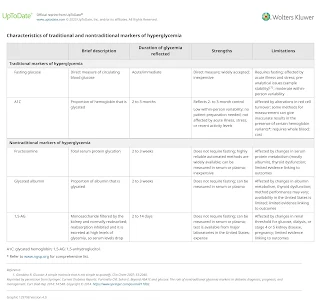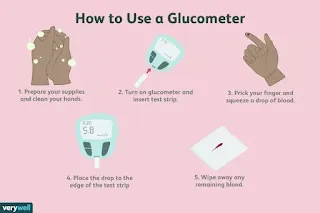Blood Glucose Measurement
Introduction
Controlling glycemia is an integral component of diabetes mellitus management.
- Patients are often advised to do self-monitoring of blood glucose with a glucometer.
Glucometer - Capillary Blood Glucose
Glucometers are highly sophisticated (requiring only a single drop of blood) and are conveniently sized and portable. It provides an instantaneous glucose level result.
- There is a misconception among the public that glucometer result reflects overall blood glucose control. They often choose to fast the night before performing the test or avoid recording the measurement after a binge eating, which then gives a false impression on blood glucose control.
Normal ranges for serum glucose concentrations are often quoted as
- Non-fasting <11.1 mmol/L
- Fasting 3.3-6.0 mmol/L
- Fasting (Impaired glucose tolerance) 6.1-7.0 mmol/L
NOTE: Inpatient glycemic target, ICU and non-ICU is 7.8-10 mmol/L. In selected patients, stricter target of 6.1-7.8 mmol/L can be considered while avoiding hypoglycemia.
Although different brands are available on the market, the method of use are fairly similar.
- Prepare your supplies and wash your hands thoroughly.
- Turn on the glucometer by inserting a test strip.
- Wipe the side of your finger with an alcohol swab for disinfection and let it dry completely.
- Prick the side of your finger with a lancing device.
- Apply a small amount of blood to the test strip according to the instructions for your specific meter.
- Wait for the reading to appear on the display.
- Wipe away any remaining blood and dispose of lancets and test strips safely.
NOTE: Newer blood glucose monitors tend to use a different reagent (glucose dehydrogenase, with or without a cofactor, rather than glucose oxidase). This reduces the susceptibility to interference from haematocrit, the partial pressure of oxygen and most drugs (aside from icodextrin, a non-glucose-containing peritoneal dialysate).
Flash and Continuous Glucose Monitoring - Interstitial Glucose
Flash glucose monitoring (available in FreeStyle Libre and Free Style Libre 2) is sensor technology that enables glucose measurement without pricking your finger. The system has 2 parts:
- A small white disc (about the size of a 20-cent coin) is positioned on the back of the upper arm. This holds the "sensor" which is worn just under the skin.
- A "reader" which when held over the sensor, gives a glucose reading.
- Hence, there is a 5-10 minutes delay than blood glucose when checking this fluid, especially after eating or if you're exercising.
Different from a flash glucose monitor which shows glucose reading only when you wave the device over the sensor, a continuous glucose monitor show the latest glucose levels on device automatically, transmitted by Bluetooth.
- Automated insulin delivery systems consists of a continuous glucose monitor with a Bluetooth-connected insulin pump. A software algorithm adjusts insulin delivery in response to real-time continuous glucose monitoring data.
HbA1c
Different from fasting glucose tests (by glucometer), glycated haemoglobin (HbA1c or A1c) reflects average levels of blood glucose over the previous 2 to 3 months (the life of a red blood cell).
- Haemoglobin A combines with glucose to form glycosylated haemoglobin (an irreversible formation).
Hence, it is very useful in monitoring of patient's actual blood glucose control (apart from to diagnose diabetes mellitus) and the result is independent of fasting status.
As part of an effort to provide worldwide standardization of all A1c assays, A1c results are reported globally in International Federation of Clinical Chemistry and Laboratory Medicine (IFCC) units (mmol/mol) and derived National Glycohemoglobin Standardization Program (NGSP) units (as percent of total haemoglobin) using a master equation.
- A1c (mmol/mol) = 10.929 * (A1c (%) - 2.15)
- Estimated average glucose (mg/dL) = (28.7 * A1c (%)) - 46.7
- Estimated average glucose (mmol/L) = Estimated average glucose (mg/dL) / 18.015
Test results
- A person who does not have diabetes: <5.7% (39 mmol/mol)
- Diabetes: 6.5% (48 mmol/mol) or higher
- Pre-Diabetes: 5.7% to 6.4% (39-46 mmol/mol)
- Target for people with diabetes mellitus: <7.0% (for most people)
NOTE: Any condition that affects the quality and quantity of red blood cells and haemoglobin (e.g. iron deficiency, bleeding, haemolysis, etc.) will affect HbA1c test results.
External Links
- Australian Prescriber - Blood glucose monitoring devices: current considerations, 2023
- tl;dr pharmacy - Continuous Glucose Monitors and Insulin Pumps: A Guide for Pharmacists, 2023
- NICE recommends continuous glucose monitoring for all patients with type 1 diabetes, 2022
- Consensus statement on the worldwide standardization of the hemoglobin A1C measurement: the American Diabetes Association, European Association for the Study of Diabetes, International Federation of Clinical Chemistry and Laboratory Medicine, and the International Diabetes Federation, 2007
- Translating the A1C assay into estimated average glucose values, 2008
- Are Blood Glucose Meters Accurate? New Data on 18 Meters, 2017
- Investigation of the Accuracy of 18 Marketed Blood Glucose Monitors, 2018
- A Perspective on the Accuracy of Blood Glucose Meters During Pregnancy, 2018
- DiABETES UK - Flash Glucose Monitors (freestyle libre) and Continuous Glucose Monitors (CGM)
- DiABETES UK - Guide to HbA1c


Comments
Post a Comment